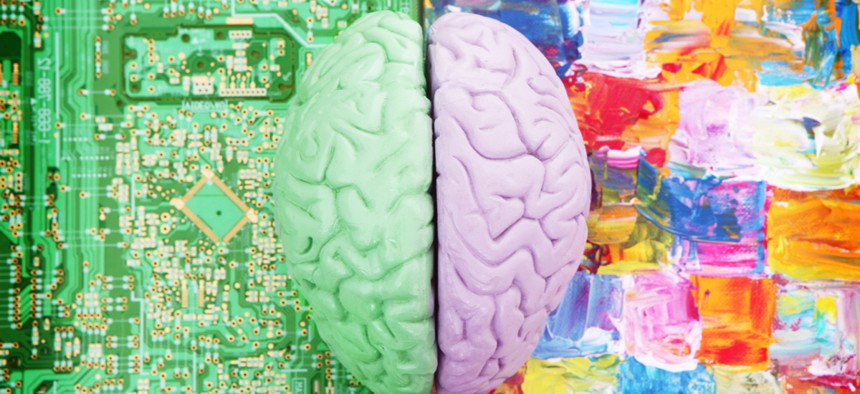The Next Big Winners in Tech Will Be the Organizations That Choose Heart Over Head

hidesy/Shutterstock.com
The power to use emotional cues to tap into our brains has never been more obvious.
Recently, an alert popped up on my colleague’s phone: “Looks like you’ve gained a few pounds. Let’s get you back on track!” The email came from the “smart” scale in her bathroom. The message, intended to motivate, was more than a little tone-deaf—especially considering she was four months pregnant.
As “smart” technology proliferates and enables the objects in our lives to sense, process, and connect, humans are on the cusp of developing a more emotional relationship with our devices. But, as my colleague can attest, we’re not quite there yet.
The power to use emotional cues to tap into our lizard brains has never been more obvious, as evidenced by our addiction to social-media feeds and our fragmentation into political tribes. But how might we coax that power out from behind the screen and back into the physical world? We can wield it to bring out the best in people, rather than just draw eyeballs for ad revenue.
The key is to design experiences around emotional value rather than rational value. Rational value is measurable and quantifiable: steps taken, calories burned, or tasks completed. Emotional value is less literal; it’s more subtle, more complex, and often less immediate. It’s how an experience makes us feel about ourselves or our relationships with others.
Never mind the industrial and technological revolutions of the past: We’re ready for an emotional revolution, in which humans develop evolving, long-term relationships with the objects around them. Recent advances in artificial intelligence give us the chance to make technology an active partner in our lives by building a deep, emotional bond between devices and users. Perhaps this will alleviate some of the overstimulation we suffer from technology every day, which forces us to engage and causes decision fatigue. Instead, it might become a source of nourishment, amusement, and fascination while alleviating some of the anxiety and polarization we currently experience.
That’s where design comes in. The fundamental role of designers is to use creativity to bridge the gap between rational and emotional—to make new technology engaging and appealing by having it meet humans on their terms. We’ve found the best way to get people to integrate new products or behaviors into their lives is to connect with them emotionally, which encourages adoption.
For example, when redesigning the voting system for Los Angeles County, IDEO heard from users that the act of casting a ballot in person had immense emotional significance. This was often particularly true for voters with vision or hearing impairments or other accessibility challenges. We created a system that allowed users to navigate and record their voting choices on their phones, then go to their polling stations, scan the devices, and easily print out physical ballots to cast by hand. We struck a balance between the rational convenience afforded by technology and the emotional meaning of preserving the voting ritual.
Gifted industrial designers such as Naoto Fukasawa and Jasper Morrisonhave demonstrated that it’s possible to pinpoint the most potent blend of rational and emotional, and quietly implement it at the most humble level. Fukasawa’s iconic example is the Muji CD player: Designed in 1999, the music device used the form and behavior of a wall fan as an intuitive interface to play digital music. They’ve shown the world the power of adding unexpected delight to ordinary objects and systems we take for granted, which feels like the right way to begin an emotional rapport with AI.
Let’s consider a deliberately ordinary example: my beloved Zojirushi insulated travel mug. I already have a good relationship with it. It works well and looks good, and I carry it with me every day. I’m a fan of the brand. How might that bond be enhanced by making the mug “smart?”
The rational approach would likely lead to something like the Vessyl“intelligent cup,” which captures data about what and how much you drink, then presents that to you via an app so you can track your nutrition and hydration. The intent is good, but it seems like information overload.
An emotional approach would start in a very different place. For example, the mug might notice that I leave it in a different spot every day, then it learns from my phone’s location data that I tend to forget it and backtrack for it after I leave the office. What if it playfully chastised me, or sent me subtle or funny reminders as I got ready to head home? Would I begin to trust it? As we developed a relationship, could it learn how to nudge me to stay hydrated without getting on my nerves, like the Vessyl might?
Business leaders have the opportunity to claim huge market value through experiences built on these emotionally intelligent objects. Over time, I would probably come to relate differently to the Zojirushi brand, not only as a high-performance mug maker, but also as a good-humored partner with my best interests at heart. Those kinds of product relationships are what create lifelong brand loyalty. And once a company establishes an emotional relationship with consumers, the organization becomes more resilient in the face of competition and changing tastes.
The emotional revolution in technology is fast approaching. Designers have the tools to integrate emotion into organizational strategy to help companies stay relevant, connect, and create value for society. Organizations that use design principles to adapt to this coming sea change and create deeper bonds with their customers will ultimately win the war for people’s minds—and hearts.





